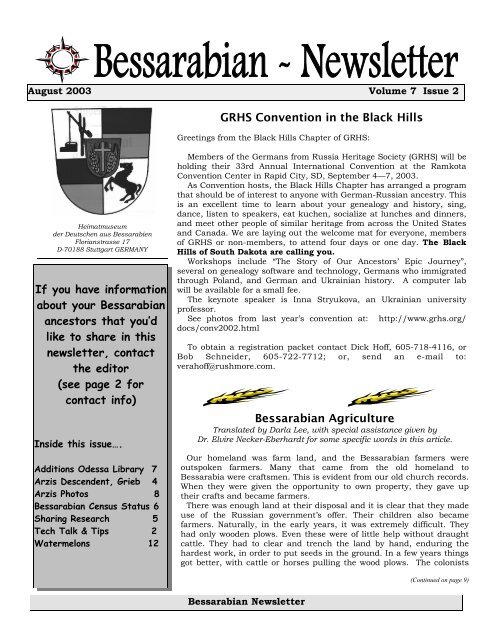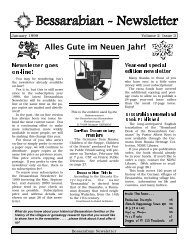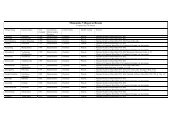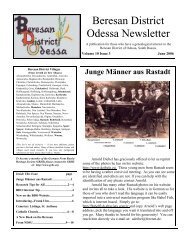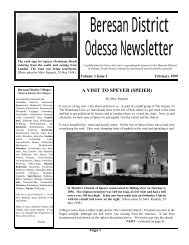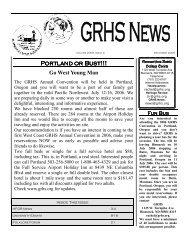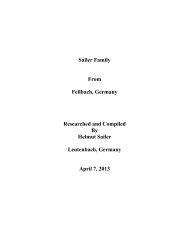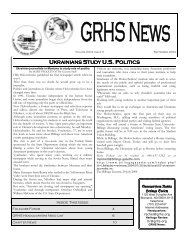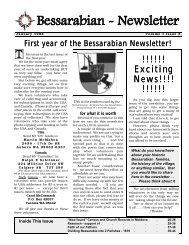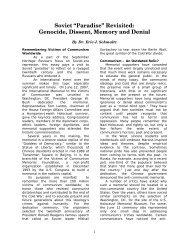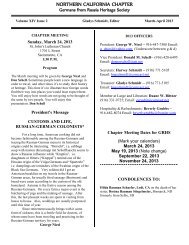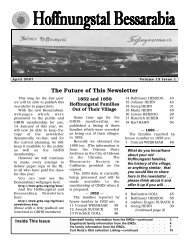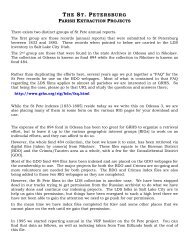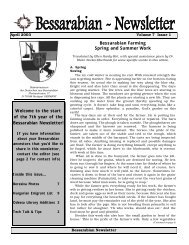Arzis, Bessarabia 2001 - Grhs
Arzis, Bessarabia 2001 - Grhs
Arzis, Bessarabia 2001 - Grhs
You also want an ePaper? Increase the reach of your titles
YUMPU automatically turns print PDFs into web optimized ePapers that Google loves.
August 2003 Volume 7 Issue 2<br />
Heimatmuseum<br />
der Deutschen aus Bessarabien<br />
Florianstrasse 17<br />
D-70188 Stuttgart GERMANY<br />
If you have information<br />
about your <strong>Bessarabia</strong>n<br />
ancestors that you’d<br />
like to share in this<br />
newsletter, contact<br />
the editor<br />
(see page 2 for<br />
contact info)<br />
Inside this issue….<br />
Additions Odessa Library 7<br />
<strong>Arzis</strong> Descendent, Grieb 4<br />
<strong>Arzis</strong> Photos 8<br />
<strong>Bessarabia</strong>n Census Status 6<br />
Sharing Research 5<br />
Tech Talk & Tips 2<br />
Watermelons 12<br />
GRHS Convention in the Black Hills<br />
Greetings from the Black Hills Chapter of GRHS:<br />
Members of the Germans from Russia Heritage Society (GRHS) will be<br />
holding their 33rd Annual International Convention at the Ramkota<br />
Convention Center in Rapid City, SD, September 4—7, 2003.<br />
As Convention hosts, the Black Hills Chapter has arranged a program<br />
that should be of interest to anyone with German-Russian ancestry. This<br />
is an excellent time to learn about your genealogy and history, sing,<br />
dance, listen to speakers, eat kuchen, socialize at lunches and dinners,<br />
and meet other people of similar heritage from across the United States<br />
and Canada. We are laying out the welcome mat for everyone, members<br />
of GRHS or non-members, to attend four days or one day. The Black<br />
Hills of South Dakota are calling you.<br />
Workshops include “The Story of Our Ancestors’ Epic Journey”,<br />
several on genealogy software and technology, Germans who immigrated<br />
through Poland, and German and Ukrainian history. A computer lab<br />
will be available for a small fee.<br />
The keynote speaker is Inna Stryukova, an Ukrainian university<br />
professor.<br />
See photos from last year’s convention at: http://www.grhs.org/<br />
docs/conv2002.html<br />
To obtain a registration packet contact Dick Hoff, 605-718-4116, or<br />
Bob Schneider, 605-722-7712; or, send an e-mail to:<br />
verahoff@rushmore.com.<br />
<strong>Bessarabia</strong>n Agriculture<br />
Translated by Darla Lee, with special assistance given by<br />
Dr. Elvire Necker-Eberhardt for some specific words in this article.<br />
Our homeland was farm land, and the <strong>Bessarabia</strong>n farmers were<br />
outspoken farmers. Many that came from the old homeland to<br />
<strong>Bessarabia</strong> were craftsmen. This is evident from our old church records.<br />
When they were given the opportunity to own property, they gave up<br />
their crafts and became farmers.<br />
There was enough land at their disposal and it is clear that they made<br />
use of the Russian government’s offer. Their children also became<br />
farmers. Naturally, in the early years, it was extremely difficult. They<br />
had only wooden plows. Even these were of little help without draught<br />
cattle. They had to clear and trench the land by hand, enduring the<br />
hardest work, in order to put seeds in the ground. In a few years things<br />
got better, with cattle or horses pulling the wood plows. The colonists<br />
<strong>Bessarabia</strong>n Newsletter<br />
(Continued on page 9)
Terms, Shorthand & URLs<br />
Organizational<br />
Village Coordinator .........................VC<br />
Village Research Project ...................VRP<br />
German Russian..............................GR<br />
GR Heritage Society .........................GRHS<br />
American Historical Society GR........AHSGR<br />
Internet<br />
Odessa Digital Library (aka “the pixel”)<br />
http://pixel.cs.vt.edu/library/odessa.html<br />
<strong>Bessarabia</strong>n Web Site<br />
http://www.bessarabia.com<br />
GRHS homepage<br />
http://www.grhs.com/<br />
AHSGR homepage<br />
http://www.ahsgr.org/<br />
NDSU Libraries Ger-Rus Heritage Collection<br />
http://www.lib.ndsu.nodak.edu/grhc<br />
US GenWeb homepage<br />
http://www.usgenweb.org/<br />
<strong>Bessarabia</strong>n Organizations in Germany<br />
http://www.bessarabien.de/bess/start.htm<br />
Genealogical Shorthand<br />
* birth/born + death/died<br />
oo m a r r i a g e<br />
Suggested dating convention - 23 Jan 1876<br />
Page 2<br />
<strong>Bessarabia</strong>n Newsletter<br />
Volume 7 Issue 2<br />
This newsletter is put together for <strong>Bessarabia</strong>n researchers by <strong>Bessarabia</strong>n researchers. There is no profit for<br />
any person, group, or organization.<br />
Published three times a year in April, August, and December<br />
Newsletter can also be viewed at www.bessarabia.com<br />
Subscription Information<br />
In USA, send $3 (US) to: In Canada, send $5 (Can) to: For Back Issues:<br />
Dianna Moran Ralph E.Schlinker Carol McCormack<br />
PO Box 799 224 Millrise Drive SW NE 24170 Highway #3 Apt #2<br />
Brewster, WA 98812 Calgary, AB T2Y 2S6 Belfair, WA 98528<br />
Outside North America, send $6 (US) to Dianna Moran<br />
Back issues are $3(US)/year or $1(US)/regular issue or $1.50(US)/year-end issue<br />
Lead Editor: Carolyn Schott Other Newsletter Volunteers:<br />
13702 Densmore Avenue North Connie Meyer<br />
Seattle, WA 98133 Horst Gutsche<br />
cgschott@earthlink.net<br />
Contributing Editor/Advisor: Dale Wahl<br />
dwahl@kendaco.telebyte.com<br />
<strong>Bessarabia</strong>n Newsletter<br />
Tech Talk and Tips<br />
Have you discovered these<br />
handy places?<br />
Charles Upson Clark's 1927 book, <strong>Bessarabia</strong>: Russia and<br />
Roumania on the Black Sea, at the University of<br />
Washington website. A detailed look at <strong>Bessarabia</strong>n<br />
history and several illustrations, many from the 1830’s:<br />
http://depts.washington.edu/cartah/text_archive/clark/<br />
toc_pag.shtml<br />
List of North Dakota Genweb files archived, listed by<br />
county:<br />
http://www.rootsweb.com/~usgenweb/nd/ndfiles.htm<br />
An online article, A Success Story: The German Colonists<br />
in New Russia and <strong>Bessarabia</strong> 1787-1914 by Professor Dr.<br />
Detlef Brandes, Dusseldorf, Germany:<br />
http://www.lib.ndsu.nodak.edu/grhc/history_culture/<br />
history/brandes.html<br />
Indexes to FANA (Familienkundliche Nachtrichten), a<br />
German genealogy publication:<br />
http://cefha.org/de/gi/fana/fana-idx.html
Volume 7 Issue 2 Page 3<br />
Festival for Ger-Rus in<br />
Alberta<br />
A festival for all Germans from<br />
Russia is being planned for<br />
September 5—7, 2003 at the<br />
Cypress Centre in Medicine Hat,<br />
Alberta.<br />
The weekend festival includes<br />
plenary and breakout sessions that<br />
will cover genealogical information,<br />
sociological and historical<br />
backgrounds, personal<br />
experiences, entertainment and an<br />
interdenominational church<br />
service. The keynote speaker will<br />
be The Right Honourable Edward<br />
Schreyer, former Premier of<br />
Manitoba, Governor General of<br />
Canada, and Canadian High<br />
Commissioner to Australia.<br />
Medicine Hat was settled heavily<br />
by Germans from Russia. Even<br />
today, 40% of the population is<br />
estimated to be of Ger-Rus<br />
heritage!<br />
For more information and<br />
registration: http://<br />
www.geocities.com/<br />
germansfromrussia/index.html<br />
SCHNEIDER LLC is planning two 17-day,<br />
personalized and affordable tours to Ukraine/<br />
Crimea/Moldova in 2004.<br />
For tour information e-mail:<br />
rschneider@rushmore.com, or click on web site:<br />
http://members.rushmore.com/~ukrainetours, or<br />
phone 605-722-7712.<br />
A SCHNEIDER LLC Tour to Ukraine is an<br />
experience you will never forget.<br />
Bob Schneider, president, Black Hills Chapter of<br />
GRHS<br />
News and Notes<br />
A Tip From a Newsletter Reader<br />
I am one of the readers who suddenly couldn't open the<br />
digital newsletter, after not having any trouble for years—<br />
an “improvement?” You probably read on the Beresan list<br />
that other people were having trouble too, and several<br />
people responded by giving the very simple method of<br />
downloading and opening pdf files.<br />
I think that it would be a good idea to print the scheme<br />
in the paper version of the <strong>Bessarabia</strong>n newsletter. It<br />
might eliminate a lot of frustration for some people. The<br />
one scheme that works for me is to right click on the pdf<br />
file and click on "Save Target as" and then specify where<br />
you want it saved. Once saved, disconnect from the<br />
Internet and then open the pdf file by double clicking on it.<br />
If you don't have a lot of RAM, the opening may take a<br />
little time, especially if there are pictures.<br />
Tours Offerings for 2004<br />
<strong>Bessarabia</strong>n Newsletter<br />
The North Dakota State University Library is<br />
pleased to announce sponsorship of the Journey to<br />
the Homeland: Germany & Ukraine Tour for May<br />
25 - June 7, 2004.<br />
The tour includes Hungary; Odessa, Ukraine<br />
and the former <strong>Bessarabia</strong>n, Black Sea and<br />
Crimean German villages; and Stuttgart, Germany<br />
and Alsace, France.<br />
For 2004 tour registration information, contact<br />
Michael M. Miller, NDSU Libraries, PO Box 5599,<br />
Fargo, ND 58105-5599<br />
(Tel: 701-231-8416; E-mail:<br />
michael.miller@ndsu.nodak.edu).
Page 4<br />
Volume 7 Issue 2<br />
<strong>Arzis</strong> Descendant, Gebhard Grieb, Represents Western Canada<br />
at 2003 PAN AMERICAN GAMES<br />
Gerhard Grieb, son of Olga Herrmann and Adolf Grieb (descendant of Christopher Grieb who was one of<br />
the founders of <strong>Arzis</strong>, <strong>Bessarabia</strong> in 1816), will represent Western Canada at the PAN AMERICAN GAMES<br />
this year at Mt. Adams, Montana, September 6 - 14, 2003.<br />
Gerhard (Gerry) and his determined wife, Audrey, are truly an amazing example of a successful amateur<br />
team who have made headlines in sport magazines and news over the last 30 years, specializing in the<br />
typical Western Canadian Sport of Endurance Riding. Gerhard arrived in Canada some 50 years ago and<br />
succeeded in breeding and coaching Arabian racing horses. As a result of his love and enthusiasm for this<br />
vocation, he has become one of the most successful breeders in North America. For many years U.S. horse<br />
owners have entrusted their valuable horses in Gerhard’s and Audrey’s care. Doing so has helped these U.S.<br />
owners to catch a glimpse of success in the North American Endurance Riding arena.<br />
Gerhard and Audrey usually finance their participation at championships through private funding. For<br />
this upcoming event, they are seeking sponsors. If you are interested in helping sponsor Gerhard this year,<br />
contact Christiane Grieb [247 Huntridge Way, NE, Calgary, AB T2K 4C4, Canada] Phone: (403) 275-2868 or<br />
e-mail christiane.grieb@web.de or info@lawbridge-ltd.com.<br />
The Horse<br />
- Special Delivery -<br />
- 11 year old gelding in<br />
the prime of his life<br />
- Provincial Champion<br />
<strong>2001</strong> & 2002<br />
Sire: top race horse<br />
Dam: top race and<br />
competitive trail horse<br />
Nine national or provincial<br />
champions in the blood line<br />
Meet the Winners!<br />
The Rider<br />
- Audrey Grieb -<br />
- born and raised in Alberta<br />
- 25+ years competitive<br />
experience<br />
- ridden in the Nationals<br />
FIVE times<br />
- Provincial endurance<br />
champion in <strong>2001</strong> & 2002<br />
- unbeaten in endurance<br />
competitions in 2002<br />
- Competitive Trail,<br />
Provincial Champion<br />
- as buddy of Special "D" a<br />
guarantee of success<br />
The Coach<br />
- Gerry Grieb -<br />
- 25+ years riding &<br />
coaching experience<br />
- ridden or coached in FIVE<br />
Nationals<br />
- '94, Alberta team took the<br />
Silver Medal, Bronze for<br />
Gerry as individual in<br />
Canada<br />
- Canadian Champion in<br />
Competitive Trail<br />
- bred, raised and coached<br />
many champions of<br />
Canada and the United<br />
States<br />
- he stands for success<br />
“In <strong>Bessarabia</strong> the horse is like family...love and care are given<br />
to the horse ahead of all other animals.”<br />
(Source: Diary of the Village Assessor of Hoffnungstal, <strong>Bessarabia</strong>.<br />
Hoffnungstal Newsletter 3-3.)<br />
<strong>Bessarabia</strong>n Newsletter
Volume 7 Issue 2 Page 5<br />
Dear Colleagues,<br />
An Offer to Share Ger-Rus Genealogy Research<br />
My ancestry extends back from Canada, through <strong>Bessarabia</strong>, Poland, and into Wuerttemberg (especially<br />
the Black Forest region), as well as other parts of today’s Germany. In some cases, these lines have been<br />
traced back to the mid-1500s.<br />
I have spent the past few years re-entering my extensive genealogical data from an old, rare software<br />
program into Family Tree Maker. Just recently, I finished an important milestone on my paternal lines:<br />
adding further names and data, checking/adding sources and writing family group biographies (some of<br />
which are up to 5 or 6 pages long). I thought that some of you might be interested in this and other<br />
information from my database. Perhaps you would like to exchange information, as well. Below is a short<br />
summary of these family surnames for both the paternal and maternal sections of my ancestry. (For each<br />
surname, I’ve also indicated their specific villages in <strong>Bessarabia</strong>. Villages for pre-<strong>Bessarabia</strong> periods are<br />
not included below, but are available from my database.)<br />
1. JA(H)NKE – Canada><strong>Bessarabia</strong> (Katzbach)>Poland, to 1781.<br />
Also includes: Kuck/Keck – <strong>Bessarabia</strong> (Kloestitz)>Poland, to 1799; KRUEGER – <strong>Bessarabia</strong> (Brienne)<br />
>Poland, to 1782; Hildebrandt – <strong>Bessarabia</strong> (Brienne).<br />
2. SANDAU – Canada><strong>Bessarabia</strong> (Katzbach)>Poland>Prussia, to 1770.<br />
Also includes: Schwab(e) – <strong>Bessarabia</strong> (Katzbach)>Prussia, to 1815; Kleiss – <strong>Bessarabia</strong> (Katzbach,<br />
Wittenberg)>Poland> Wuerttemberg, to 1750; Kohler – <strong>Bessarabia</strong> (Krasna)>Poland, to 1792;<br />
Heinzelmann – Poland> Wuerttemberg, to 1750. Also includes: FINKBEINER – Canada><strong>Bessarabia</strong><br />
(Katzbach/Alt Postal, Wittenberg)>Poland>Wuerttemberg, to 1570; Riedel – <strong>Bessarabia</strong> (Katzbach, Krasna)<br />
>Poland, to 1795; Schill –<strong>Bessarabia</strong> (Katzbach)>Poland>Wuerttemberg, to 1770; Grimm – <strong>Bessarabia</strong> (Alt<br />
Postal, Wittenberg)>Poland>Wuerttemberg, to 1758.<br />
3. STICKEL – Canada><strong>Bessarabia</strong> (Albota, Wittenberg)>Poland>Wuerttemberg, to 1565.<br />
Also includes: Mack – <strong>Bessarabia</strong> (Wittenberg)>Poland>Wuerttemberg, to pre-1763; SULZ – <strong>Bessarabia</strong><br />
(Wittenberg)>Poland>Wuerttemberg, pre-1782; Hach – <strong>Bessarabia</strong> (Wittenberg, Kloestitz)>Poland, to pre-<br />
1817; Flaig – <strong>Bessarabia</strong> (Wittenberg, Alt Postal>Poland>Wuerttemberg, to 1760; Hafner – <strong>Bessarabia</strong> (Alt<br />
Postal)>Poland>Wurttemberg, to 1692.<br />
4. SEITZ – Canada><strong>Bessarabia</strong> (Wittenberg)>Poland>Wuerttemberg, to 1662.<br />
Also includes: Majer – Wuerttemberg, to pre-1735; Staeb – <strong>Bessarabia</strong> (Wittenberg) >Prussia/<br />
Poland>Wuerttemberg, to 1768; Hildwein – <strong>Bessarabia</strong> (Wittenberg)>Poland>Wuerttemberg, to pre-1700s;<br />
Mueller – <strong>Bessarabia</strong> (Wittenberg)>Poland>Wuerttemberg, to 1767; Bohnet – <strong>Bessarabia</strong> (Wittenberg)<br />
>Poland>Wuerttemberg, to 1581.<br />
If any of this information interests you, please let me know. I can then e-mail a Word document that lists<br />
the names of the more than 800 deceased individuals in my family tree, including birth, death and place<br />
names for each one. If you see something of interest in that list, I can supply family group sheets by email,<br />
as well. (I could also provide hardcopies of this information for the cost of materials and postage.)<br />
Dwayne Janke<br />
4304 55 St. NE<br />
Calgary AB T1Y 4B7<br />
Canada<br />
E-mail: dwayne.janke@3web.net<br />
<strong>Bessarabia</strong>n Newsletter
Page 6<br />
Status of <strong>Bessarabia</strong>n Censuses<br />
<strong>Bessarabia</strong>n Newsletter<br />
Volume 7 Issue 2<br />
More censuses are being extracted and prepared for publication—here’s the current status<br />
1835 1850 1858 1859 1860 1861<br />
Alt <strong>Arzis</strong> X X<br />
Alt Elft X X<br />
Alt Posttal X X<br />
Beresina X X<br />
Borodino 5 X<br />
Brienne 2 X 0<br />
Dennewitz na X<br />
Friedenstal X X 0<br />
Gnadental 2 X 0 0<br />
Hoffnungstal na X X<br />
Katzbach 0 na<br />
Klöstitz X X 0<br />
Krasna 3 6<br />
Kulm X X 0<br />
Leipzig 3 X 0<br />
Lichtental X X<br />
Neu <strong>Arzis</strong> 3 X<br />
Neu Elft X X 1 0<br />
Paris 3 X 0<br />
Plotzk na X<br />
Sarata 1 X<br />
Schabo 1 1<br />
Tarutino X X X<br />
Teplitz X 0<br />
Wittenberg X X<br />
0 = To be extracted<br />
1 = Extracted, to be input<br />
2 = Input complete<br />
3 = First review<br />
4 = Second review<br />
5 = Final review<br />
6 = Proofing<br />
X = Published<br />
Na = None available
Volume 7 Issue 2 Page 7<br />
Recent Additions to the Odessa Digital Library<br />
3 Jul 2003 sarata.txt Sarata <strong>Bessarabia</strong> - a Koblenz Extraction (E. Wise)<br />
8 Jun 2003 parusch.txt Paruschofka <strong>Bessarabia</strong> - a Koblenz Extraction (E. Wise)<br />
8 Jun 2003 pawlow.txt Pawlowka <strong>Bessarabia</strong> - a Koblenz Extraction (E. Wise)<br />
8 Jun 2003 plotzk.txt Plotzk <strong>Bessarabia</strong> - a Koblenz Extraction (E. Wise)<br />
8 Jun 2003 popasdru.txt Popasdru <strong>Bessarabia</strong> - a Koblenz Extraction (E. Wise)<br />
8 Jun 2003 raska.txt Raskajetz <strong>Bessarabia</strong> - a Koblenz Extraction (E. Wise)<br />
8 Jun 2003 reul.txt Reulingen-Reiling <strong>Bessarabia</strong> - a Koblenz Extraction (E. Wise)<br />
8 Jun 2003 risch.txt Rischkanowka <strong>Bessarabia</strong> - a Koblenz Extraction (E. Wise)<br />
8 Jun 2003 romana.txt Romanowka <strong>Bessarabia</strong> - a Koblenz Extraction (E. Wise)<br />
8 Jun 2003 romano.txt Romanowo <strong>Bessarabia</strong> - a Koblenz Extraction (E. Wise)<br />
8 Jun 2003 rosenf.txt Rosenfeld <strong>Bessarabia</strong> - a Koblenz Extraction (E. Wise)<br />
8 Jun 2003 sanger.txt Sangerowka <strong>Bessarabia</strong> - a Koblenz Extraction (E. Wise)<br />
8 Jun 2003 mcphersd.txt McPherson County SD Cemeteries (E. Morrison)<br />
8 Jun 2003 zionhist.txt History of Zion American Lutheran Church, Eureka SD, 1964<br />
8 Jun 2003 ewzmsc58.txt EWZ Index for Miscellaneous Films 58 (E. Wise)<br />
8 Jun 2003 ewzmsc60.txt EWZ Index for Miscellaneous Films 60 (E. Wise)<br />
8 Jun 2003 ewzmsc61.txt EWZ Index for Miscellaneous Films 61 (A. Marthaller)<br />
26 May 2003 flug1.txt Flug, Rath, and Bogner GEDLIST (R. Roth) - Tarutino<br />
18 May 2003 ntarut.txt Neu Tarutino <strong>Bessarabia</strong> - a Koblenz Extraction (E. Wise)<br />
18 May 2003 nusstal.txt Nusstal <strong>Bessarabia</strong> - a Koblenz Extraction (E. Wise)<br />
18 May 2003 olone.txt Oloneschti <strong>Bessarabia</strong> - a Koblenz Extraction (E. Wise)<br />
18 May 2003 parapara.txt Parapara <strong>Bessarabia</strong> - a Koblenz Extraction (E. Wise)<br />
18 May 2003 Paris.txt Paris <strong>Bessarabia</strong> - a Koblenz Extraction (E. Wise)<br />
18 May 2003 nmath.txt Neu Mathildendorf <strong>Bessarabia</strong> - a Koblenz Extraction (E. Wise)<br />
18 May 2003 mortonnd.txt Morton County ND Cemeteries (E. Morrison)<br />
18 May 2003 nodessa.txt Neu Odessa <strong>Bessarabia</strong> - a Koblenz Extraction (E. Wise)<br />
18 May 2003 nonescht.txt Neu Oneschti <strong>Bessarabia</strong> - a Koblenz Extraction (E. Wise)<br />
18 May 2003 nstrymba.txt Neu Strymba <strong>Bessarabia</strong> - a Koblenz Extraction (E. Wise)<br />
18 May 2003 dai353-4.txt DAI films 353 & 354 - Report of Contents (R. Benert)<br />
18 May 2003 ewz50b.txt EWZ Index for A3342-EWZ 50-H056 (S. Schochenmaier)<br />
18 May 2003 ewzmsc55.txt EWZ Index for Miscellaneous Films 55 (E. Bischoff)<br />
18 May 2003 ewzmsc56.txt EWZ Index for Miscellaneous Films 56 (E. Bischoff)<br />
14 May 2003 eisen.txt Eisenbeisz Family Genealogy (C. Eisenbeis)<br />
10 May 2003 sherind.txt Sheridan County ND Cemeteries (E. Morrison).<br />
<strong>Bessarabia</strong>n Newsletter
Sign with town name on the road into Arcis<br />
Photo by Elli Wise. Used with permission.<br />
Page 8<br />
<strong>Arzis</strong>, <strong>Bessarabia</strong> <strong>2001</strong><br />
View of a typical house in Arcis, taken from the street.<br />
Photo by Elli Wise. Used with permission<br />
<strong>Bessarabia</strong>n Newsletter<br />
Volume 7 Issue 2<br />
German church—being renovated in <strong>2001</strong><br />
Photo by Carolyn Schott
Volume 7 Issue 2 Page 9<br />
made complete farm implements in their living rooms during the long winter evenings. The seed had to be<br />
scattered by hand. It was a difficult and arduous farm duty. With time, things improved. The plow had<br />
originally only a wooden Grindel. (1) By and by, this also disappeared and was completely replaced by the iron<br />
plow.<br />
In later years, the farmers had the famous Eberhard plow from Wuerttemberg. The farmers mostly made<br />
the harrows themselves. They were wooden at first, but later were made of iron. Seeding was done by a driller<br />
instead of by hand, and eventually by tractor. In the early years, mowing was done with sickle and scythe.<br />
Later this was accomplished with rake and reel machines. For threshing one used a flail brought from the<br />
homeland. A threshing stone place was prepared, the grain was spread out; horses were tied to the “threshing<br />
stone” and made to go around in a circle. Thus the grain was threshed. In later years a threshing machine<br />
was used. The “Wiesbaum” wagon evolved into the “harbie” wagon, a big cart with a sparred frame. The<br />
broken grain was originally cleaned with a winnowing shovel. This was replaced by a cleaning mill.<br />
The first settlers had only primitive farm implements at their disposal, so they had to leave much of the land<br />
unplanted in the early years. In these “Heuschlag” (2) pastures, the big herds of cattle, horses and sheep were<br />
grazed. The horses that were not needed for farming were also brought to the pasture. Later more and more<br />
land was farmed, as the farmers improved their equipment. The pastures became smaller. In order to<br />
maintain the number of their herds and be able to bequeath their sons a relatively good farm, they began to<br />
buy land outside of the village district from their foreign neighbors. In those days the governmentapportioned<br />
land was no longer sufficient, the land that they had greatly enlarged despite difficult times,<br />
pestilence and epidemics.<br />
About 8,000 persons in total came to <strong>Bessarabia</strong> during the settlement times. Some 92,000 people returned<br />
to Germany in 1940. Added to this were about 15,000 who emigrated to Dobrudscha and 20,000 that moved<br />
to America (3).<br />
<strong>Bessarabia</strong>n Agriculture (Continued from page 1)<br />
The emigration occurred in the years between 1857 and 1927. We can see from these numbers<br />
how prolific our ancestors were. There were families with 12 to 14 children, even up to 18 children.<br />
To get a better idea of the population mixture and the rise in population, I present the following statistics<br />
(from Pambook’s The Homecoming of the <strong>Bessarabia</strong>n Germans):<br />
Total population in 1861---1,026,346<br />
1891—1,641,559<br />
1897—1,935,412<br />
1919---2,631,000<br />
1936---2,863,409<br />
German (population) 1861---33,501<br />
1891---42,681<br />
1897---59,998<br />
1919---79,000<br />
1936---2.8 % (4)<br />
Rumanian (population) 1861---692,000<br />
1891---1,089,995<br />
1897---921,256<br />
1919---1,683,000<br />
1936---52.2%<br />
Ukrainian (population) 1861---162,252<br />
1891---223,251<br />
1897---379,341<br />
1919---254,000<br />
1936---11%<br />
<strong>Bessarabia</strong>n Newsletter<br />
(Continued on page 10)
<strong>Bessarabia</strong>n Agriculture (Continued from page 9)<br />
Russian (population) 1861---162,252<br />
1891---34,473<br />
1897---158,704<br />
1919---134,000<br />
1936---12.3%<br />
Bulgarian (population) 1861---25,684<br />
1891---85,361<br />
1897---102,577<br />
1919---Not available<br />
1936---5.8%<br />
Jewish (population) 1861---91,590<br />
1891---141,175<br />
1897---228,379<br />
1919---267,000<br />
1936---7.2%<br />
Gypsy (population) 1861---18,983<br />
1891---16,415<br />
1897---Not available<br />
1919---Not available<br />
1936---0.5%<br />
Page 10<br />
<strong>Bessarabia</strong>n Newsletter<br />
Volume 7 Issue 2<br />
Various (population) 1861---336<br />
1891---8,208 (3,283 Armenians, 3,283 Greeks, 1,642 Poles and Swiss)<br />
1897---85,157 (36,127 Gagauz (6), 3,806 Poles, 23,224 Others: Gypsies, Greeks,<br />
and Armenians)<br />
1919---214,000 (147,000 Bulgarians and Gagauz, 67,000 others)<br />
1936---4.9% (Polish: 0.3%; Gagauz: 3.5%; Gypsies: 0.5%; other 0.4%)<br />
Density (5) 1864---Not available<br />
1891---36.9<br />
1897---43.5<br />
1919---59.2<br />
The above clearly indicates that the Rumanians in <strong>Bessarabia</strong> had the greatest population.<br />
Our forefathers received 147,705 hectares of land from the Russian state. They acquired land totaling<br />
182,295 hectares. Besides this amount, they leased a considerable amount of land (24,177 hectares). The<br />
land was generally very fertile. The condition of the soil differed. As well as the rich humus (black earth), a<br />
small range of soil with salt peter, clay and sand was also found.<br />
Farming<br />
During the immigration years, our forefathers planted mainly summer wheat (Arnaut, red rotation<br />
wheat) and rye. Later they went to winter wheat, barley, some oats and a lot of maize (field corn), because<br />
these types of grain produced well here. The “six-row barley” brought an especially high yield. This was also<br />
true of the maize. The barley and oats served as food for the horses. The colts were raised mostly on oats.<br />
Maize was the best fattening diet (for animals).<br />
In the final years that we were there, the export trade had intensified and soybeans, sunflowers, and<br />
sugar cane were also planted. These things brought the most money into the household. One must not<br />
forget the wonderful water and musk melons. Rapid development was also experienced in wine growing and<br />
(Continued on page 11)
Volume 7 Issue 2 Page 11<br />
<strong>Bessarabia</strong>n Agriculture (Continued from page 10)<br />
it became a major industry for the Germans in South <strong>Bessarabia</strong> (Schabo).<br />
The “three-field harvest” system was used. In the first year land was seeded with maize (also called<br />
Welshcorn or “Popschei”). Afterward, barley or winter wheat usually followed. In the third year, oats, winter<br />
wheat or barley was planted. Then without fail maize was planted again in order to keep the land free of<br />
weeds.<br />
Because of frequent crop failures, the so-called “Magazine” was soon built. These were high grain<br />
elevators that were erected by the people. In record years, grain was stored there for protection against poor<br />
harvest years. Manure was not used. The virgin earth was fertile enough without it.<br />
Tree Growing<br />
Trees were highly regarded by many of our ancestors. They were used to them back in their old homeland<br />
of Wuerttemberg. When someone who was born and raised in the Steppes experiences spring in the old<br />
homeland, he will well understand this love of trees, because spring in Schwabia is a garden; indeed, a<br />
paradise! Everything is blooming. Trees border the streets, farmyards, fields and meadows. Can anything<br />
else be so beautiful? From this garden our ancestors came to the almost treeless region of <strong>Bessarabia</strong>. It is<br />
understandable that they immediately reserved a large area of land near the village for woods and fruit trees.<br />
Just as in other areas, the trees were planted in an orderly fashion. The orchard had apple, pear, plum,<br />
apricot, peach and cherry trees. In the “little forest” there were primarily acacias, elms and alder trees. The<br />
orchards were especially well cared for. They were regularly pruned and weeded. The trees were trimmed,<br />
sprayed, and the trunks whited, so that no harm could come to them. In time the old trees were replaced.<br />
The young fruit trees grew under the care of the people. In the later years, the trees were surrounded by wire<br />
net to protect them from vandalism by senseless youths or adults.<br />
A different fate befell the “forest” trees. After many years the people stopped weeding there. The<br />
couch grass took over and before long the “forest” became a wilderness. Many farmers went to their “piece of<br />
land,” their “parcel” for needed wood. Later plantings were not successful. In all too few years, the “little<br />
forest” disappeared.<br />
During the later years, some community members decided to appoint new land for the purpose of<br />
planting trees. As a result, a new “small forest” was planted. It grew well because the trees were looked after,<br />
but during the last war, when we were away, the trees were neglected. Would this be the case today? The<br />
woods and the orchards were indicative of our neighborhoods. One did not find them in non-German<br />
colonies.<br />
Much care was devoted to trees planted in the yard. The acacia grew the best. Poplars were also<br />
often planted in front of the doors of the houses. The large, leafy crown provided protection against the high<br />
heat of summer, which rose to more than 104 degrees. The blooming of spring was a lovely time. A pleasant<br />
scent permeated the area. Bees buzzed through the air, gathering honey. The acacia honey was the favorite<br />
and the most expensive.<br />
As with all the previous sketches, we see that our homeland demanded hard work. The abundance<br />
with which it blessed us, however, made us forget the difficulties and hardships. We loved the soil of our<br />
homeland. It was our native land.<br />
Translator’s notes:<br />
(1) Although the context of this sentence seems to indicate that “Grindel” is a part on a plow, the exact<br />
meaning of this word is not known.<br />
(2) "Heuschlag" pastures were the original uncultivated “steppe” land of Southern Russia (similar to the<br />
prairies of North America). These pastures were used to graze big herds of cattle, horses and sheep.<br />
(3) It is not known if the original author meant “North America” in using the term “America.” This is<br />
sometimes the case in <strong>Bessarabia</strong>n-German writings. If so, then this emigration figure would relate to<br />
both the U.S. and Canada. Other sources for emigration statistics may help clarify this figure.<br />
(4) The original German version of this article used the figure 28%. However, comparing this with the rest of<br />
the figures for other years and nationalities, this appears to be a simple typographical error (i.e. it<br />
(Continued on page 12)<br />
<strong>Bessarabia</strong>n Newsletter
Page 12<br />
Volume 7 Issue 2<br />
<strong>Bessarabia</strong>n Agriculture (Continued from page 11)<br />
should read 2.8%, not 28%). This figure would translate into a population of 80,175 Germans in<br />
<strong>Bessarabia</strong> in 1936.<br />
(5) It is not clear exactly what information this section on “density” is trying to convey. In the original article,<br />
all of the population statistics are organized in a table. The “density” figures 36.9, 43.5 and 59.2<br />
(without percentage marks) are listed under the figures for 1891, 1897 and 1919 respectively. If these<br />
figures are meant to be population densities, they are likely conveying the number of people per<br />
standard area of land (i.e. square kilometer, hectare, etc.). It appears that these numbers may be<br />
population density figures per hectare, since using the square-kilometer figure from the original<br />
Heimatbuch der Bessarabiendeutchen in German results in figures that are less than half of those listed<br />
here, and since hectares are used in other places in this article.<br />
(6) The name of a Turkish ethnic group.<br />
Editor’s Note: This article is from the book, Wie’s Daheim War—Der Schicksalsweg der<br />
Bessarabiendeutschen, by J. Becker, published 1950. This is part of an ongoing series of articles being<br />
translated for publication in this newsletter. If you would like to help translate other articles from this book<br />
about <strong>Bessarabia</strong>n-German social history, contact coordinator Dwayne Janke by e-mail at<br />
dwayne.janke@3web.net.<br />
Based on how many watermelon recipes appear in Ger-Rus cookbooks and the special mention in the article<br />
above, watermelons were an important crop for our ancestors. As you can see from this photo, they’re also<br />
an important crop today! This photo was taken in <strong>2001</strong> along the road just outside Odessa. Produce sellers<br />
camp out alongside their piles of produce until it sells.<br />
A close friend (and possible distant cousin—you never know with all these convoluted Ger-Rus<br />
relationships!) told me that he’d heard that our ancestors didn’t know about watermelons in Germany, but<br />
only “discovered” them in Russia. Since the word used by Ger-Rus is more often “Arbus” (the Ukrainian<br />
word) rather than the German “Wassermelon,” this would seem to be a credible story. But if anyone has<br />
more information, let me know!<br />
Photo by Elaine Morrison. Used with permission.<br />
<strong>Bessarabia</strong>n Newsletter


